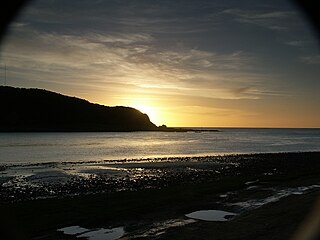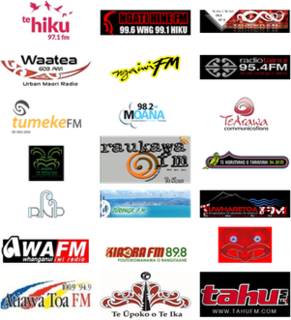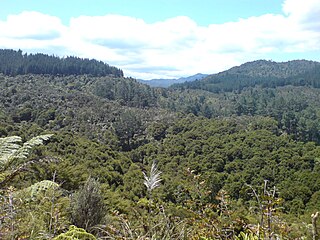
Ngāti Whātua is a Māori iwi (tribe) of the lower Northland Peninsula of New Zealand's North Island. It comprises a confederation of four hapū (subtribes) interconnected both by ancestry and by association over time: Te Uri-o-Hau, Te Roroa, Te Taoū, and Ngāti Whātua-o-Ōrākei. The four hapū can act together or separately as independent tribes.

Ngāti Toa, Ngāti Toarangatira or Ngāti Toa Rangatira, is a Māori iwi (tribe) in the lower North Island and upper South Island of New Zealand. Its rohe extends from Whanganui in the north, Palmerston North in the east, and Kaikoura and Hokitika in the south. Ngāti Toa remains a small iwi with a population of only about 4500. It has four marae: Takapūwāhia and Hongoeka in Porirua, and Whakatū and Wairau in the north of the South Island. Ngāti Toa's governing body has the name Te Rūnanga o Toa Rangatira.

Ngāti Awa is a Māori iwi (tribe) centred in the eastern Bay of Plenty Region of New Zealand. It is made of 22 hapu (subtribes), with 15,258 people claiming affiliation to the iwi in 2006. The Ngāti Awa people are primarily located in towns on the Rangitaiki Plain, including Whakatane, Kawerau, Edgecumbe, Te Teko and Matata. Two urban hapu also exist in Auckland and Wellington.

Te Āti Awa is a Māori iwi with traditional bases in the Taranaki and Wellington regions of New Zealand. Approximately 17,000 people registered their affiliation to Te Āti Awa in 2001, with around 10,000 in Taranaki, 2,000 in Wellington and around 5,000 of unspecified regional location.

Ngāti Ranginui is a Māori iwi (tribe) in Bay of Plenty, New Zealand. Its rohe extends from Waihi in the north, to the Kaimai Range in the west, to south of Te Puke in the south, and to Tauranga in the east. The rohe does not extend offshore to Matakana Island or Mayor Island / Tuhua.

Ngāti Kurī is a Māori iwi from Northland, New Zealand. The iwi is one of the five Muriwhenua iwi of the far north of the North Island. Ngāti Kurī trace their whakapapa (ancestry) back to Pōhurihanga, the captain of the waka (canoe) Kurahaupō. Kurī means dog in Māori. The rohe of the iwi is focused on the most northern tip of the North Island and includes the Kermadec Islands, Three Kings Island, Cape Reinga, Ninety Mile Beach, Parengarenga Harbour, Te Kao and Houhara.
Ngāti Rangitihi is a Māori iwi of Aotearoa New Zealand, located in the Bay of Plenty.

Ngāti Whanaunga is a Māori iwi (tribe) of the Coromandel Peninsula in New Zealand, descended from Whanaunga, the third son of Marutūāhu.

Rongowhakaata is a Māori iwi of the Gisborne region of New Zealand.

Te Aitanga-a-Mahaki is one of the three principal Māori iwi of the Tūranga district; the others being Rongowhakaata and Ngai Tamanuhiri. It is numerically the largest of the three, with 6,258 affiliated members as of 2013.

For the ship see RMS Rangitane

Ranana is a settlement 60 kilometres (37 mi) up the Whanganui River from Whanganui, New Zealand. Originally known as Kauika, it grew after 1848 as local Māori moved out of fortified pā settlements in peacetime. It was renamed by the missionary Richard Taylor in 1856 for Rānana, a Māori transliteration of London. Its Catholic church, built in the 1880s for the hapū Ngāti Ruakā of the iwi Te Āti Haunui-a-Pāpārangi, is still in use, as is the Ruakā marae. Nearby is Moutoa Island, site of a famous battle in 1864.

Ātene is a former village located 35 kilometres (22 mi) up the Whanganui River from Whanganui. Originally called Warepakoko, then Kakata, it was renamed by the missionary Richard Taylor in the 19th century as a Māori transliteration of Athens. It was the home of the hapū Ngāti Hineoneone of the iwi Te Āti Haunui-a-Pāpārangi. A small meeting house called Te Rangi-i-heke-iho, restored by carver Bill Ranginui, is all that remains.

Te Whakaruruhau o Ngā Reo Irirangi Māori is a New Zealand radio network consisting of radio stations that serve the country's indigenous Māori population. Most stations receive contestable government funding from Te Māngai Pāho, the Māori Broadcast Funding Agency, to operate on behalf of affiliated iwi (tribes) or hapū (sub-tribes). Under their funding agreement, the stations must produce programmes in the Māori language, and must actively promote Māori culture.

Kaiwhaiki is a settlement 18 kilometres (11 mi) upriver from Whanganui, New Zealand.

Ngāti Rongoū is a Māori iwi (tribe) of the Coromandel Peninsula in New Zealand.

Ngāti Whātua-o-Ōrākei or Ngāti Whātua Ōrākei is an Auckland-based Māori hapū (sub-tribe) in New Zealand. Together with Te Uri-o-Hau, Te Roroa and Te Taoū, it comprises the iwi (tribe) of Ngāti Whātua. The four hapū can act together or separately as independent tribes. The hapu's rohe is mostly in Tāmaki Makaurau, the site of present-day Auckland.
Hauāuru Māori are a group of Māori iwi at or around the west coast of the North Island of New Zealand. It includes the iwi (tribe) of Te Āti Haunui-a-Pāpārangi and its affiliated iwi of Ngāti Hau. It also includes the iwi of Ngāti Tama, Ngāti Mutunga, Te Āti Awa, Taranaki, Ngāti Maru, Ngāruahine, Ngāti Ruanui, Ngā Rauru, Te Korowai o Wainuiārua, Ngāti Rangi, Ngāti Apa and Ngāti Hauiti.



















